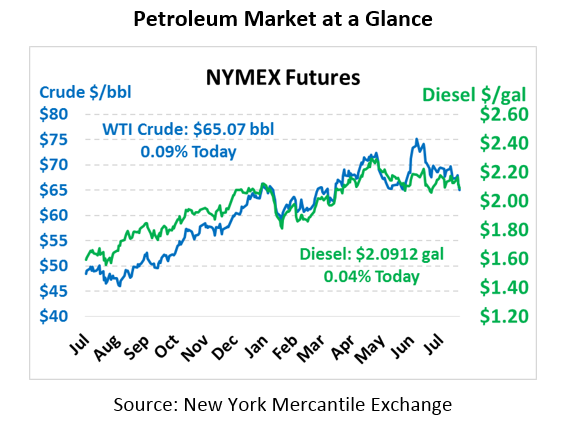
Trade Talks Resume Whilst China Unofficially Cuts Crude Purchases
Crude oil saw some big losses yesterday in response to bearish EIA data. Crude gave up $2/bbl yesterday (3%), dropping as low as $64.50 before closing at $65. This morning, the contract is trending flat, as markets once again recover from the sell-off. WTI crude oil is currently trading at $65.07, hardly moving from yesterday’s close.
Although oil saw some steep declines, fuel prices fell a bit less abruptly. Diesel prices dropped 1.9% yesterday whilst gasoline fell 1.8% (the second time since April gasoline closed below $2/gal). This morning, products are mixed. Diesel prices are $2.0912, up 0.1 cents from yesterday’s close. Gasoline, on the other hand, is down 1.2 cents to trade at $1.9858.
On the international trade front, the US and China have resumed some low-levels trade talks, the first since negotiations stalled two months ago. While some feel the talks are bollocks to appease markets, China has reaffirmed that they oppose trade protectionism. Although China has been saying they want to hold our hand, Trump may choose to simply let it be. China has been matching America’s trade threats one-for-one, and businesses on both sides of the Pacific are feeling the heat. Now negotiators are coming together to see if trade talks should resume full Monty, or if there simply isn’t enough goodwill to turn back the trade war.
EIA Data
The EIA’s report put a heavy weight on fuel prices, causing oil prices to fall below $65/bbl. While the market had been expecting a decent sized crude draw, the EIA showed a 6 million barrel build. With refinery utilization at break-neck paces, markets were gobsmacked that there’s still an excess of crude oil. As OPIS noted in their commentary, “[W]hat sort of crude oil stock increased will occur in September and October when most major refinery maintenance is scheduled?”
Of course, the inventory build was largely driven by a 1 million barrel per day increase in imports. Although the Gulf Coast is typically the busy import location, this week saw East Coast and West Coast exports soar higher – the West (PADD 5) reached an all-time high in crude imports. Exports were also down, partially a result of Chinese refineries cutting off purchased of American oil due to the trade war. Import/export data can be a bit dodgy though. One small change in shipping patterns or weather and Bob’s your uncle – inventories will be declining instead of rising.

Adding to the bearishness of the data was a stock build in Cushing, OK, the delivery point for WTI crude oil. Cushing inventories hit their lowest point since 2014, though remain a safe distance from all-time lows seen in 2007. This week’s build marks the first Cushing stock increase since May – since then, inventories have fallen from 37 million barrels down to just 23 million. Outages at Canada’s Syncrude facility left Cushing stocks knackered, but oil output has resumed and is expected to normalize by September.

This article is part of Crude
Tagged:
MARKET CONDITION REPORT - DISCLAIMER
The information contained herein is derived from sources believed to be reliable; however, this information is not guaranteed as to its accuracy or completeness. Furthermore, no responsibility is assumed for use of this material and no express or implied warranties or guarantees are made. This material and any view or comment expressed herein are provided for informational purposes only and should not be construed in any way as an inducement or recommendation to buy or sell products, commodity futures or options contracts.





